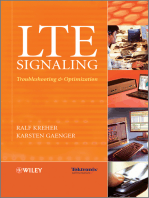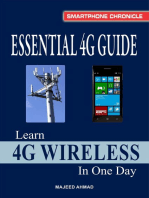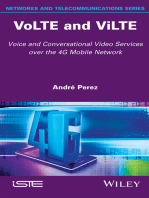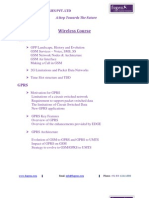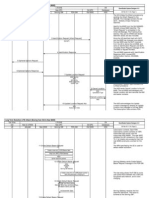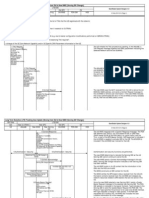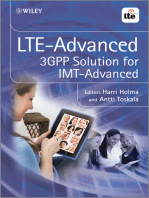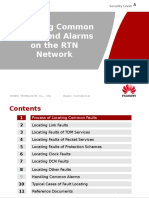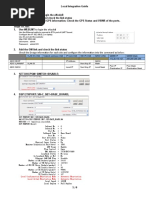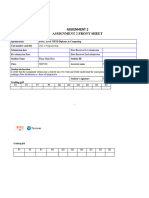50%(4)50% found this document useful (4 votes)
895 viewsLTE Protocol Stack Testing
The document discusses the LTE protocol stack and related technologies. It covers topics like GSM, UMTS, LTE architecture and interfaces, protocol layers including PDCP, RLC, MAC, RRC, NAS. Modulation techniques, multiple access schemes, and call procedures are also explained. Testing tools and scripting languages for protocol testing are described.
Uploaded by
mohdwajid2009Copyright
© © All Rights Reserved
Available Formats
Download as PDF, TXT or read online on Scribd
50%(4)50% found this document useful (4 votes)
895 viewsLTE Protocol Stack Testing
The document discusses the LTE protocol stack and related technologies. It covers topics like GSM, UMTS, LTE architecture and interfaces, protocol layers including PDCP, RLC, MAC, RRC, NAS. Modulation techniques, multiple access schemes, and call procedures are also explained. Testing tools and scripting languages for protocol testing are described.
Uploaded by
mohdwajid2009Copyright
© © All Rights Reserved
Available Formats
Download as PDF, TXT or read online on Scribd
You are on page 1/ 2
LTE PROTOCOL STACK TESTING
SECTION-1: Introduction about wireless technologies
1.1) GSM Architecture
1.2) UMTS Architecture
1.3) Frame architectures of GSM & UMTS
1.4) Protocol stack architecture of UMTS
1.5) UMTS Channels
1.6) Spreading Factor
SECTION-2: Modulation & Multiple Access Schemes
2.1) Different Modulation schemes: BPSK, QPSK, QAM, 16-QAM & 64-QAM
2.2) Different Multiple Access Schemes: TDMA, FDMA, CDMA, WCDMA, OFDMA & SCFDMA
2.3) FDD & TDD
SECTION-3: Introduction to LTE
3.1) Comparison of LTE with different Technologies
3.2) LTE High level architecture with different interfaces
3.3) LTE interfaces with corresponding protocols
3.4) LTE Protocol Stack Architecture
3.5) LTE Channels
3.6) Understanding of Data and Signaling Communication
3.7) LTE Frame Architecture
3.8) LTE Bearer Management
3.9) Signaling Radio Bearers
3.10) Geographical Areas
3.11) Network Identities
3.12) LTE Resource Grid
3.13) OFDMA
3.14) SCFDMA
3.15) Cell Acquisition Procedure
SECTION-4: RRC (Radio Resource Control)
4.1) UE –RRC States
4.2) RRC connection Establishment
4.3) System Information Acquisition
4.4) Initial Security Activation
4.5) RRC Connection Reconfiguration
4.6) RRC Connection Reestablishment
4.7) RRC Connection Release
4.8) Handovers
4.9) Radio resource configuration
SECTION-5: NAS (Non-Access Stratum)
5.1) EMM States
5.2) ECM/ESM States
5.3) LTE Registration/Attach Procedure
5.4) Tracking Area Update Procedure
5.5) Service Request Procedure
5.6) S1 Release Procedure
5.7) Detach Procedure
5.8) NAS Security Activation
SECTION-6: PDCP (Packet Data Convergence Protocol)
6.1) PDCP Architecture
6.2) PDCP Procedures
6.3) Header Compression & Decompression States
6.4) PDCP Security Functions
6.5) PDCP PDU Formats
SECTION-7: RLC (Radio Link Control)
7.1) RLC Architecture
7.2) RLC Entities
7.3) RLC Modes
7.4) Transmission & Reception of Data
7.5) ARQ Procedures
7.6) RLC PDU Formats
SECTION-8: MAC (Medium Access Control)
8.1) MAC Architecture
8.2) Random Access Procedure
8.3) HARQ operation
8.4) Logical Channel Prioritization
8.5) Scheduling request
8.6) Buffer Status Reporting
8.7) Power Headroom Reporting
8.8) Discontineous Reception
8.9) Semi-persistant Scheduling
8.10) MAC Scheduler
8.11) MAC PDU Formats
SECTION-9: CS Procedures
9.1) CSFB
9.2) IMS
9.3) SIP
9.4) Voip
9.5) RTP & RTCP
SECTION-10: Wireless Testing Tools
10.1) Protocol Debugging Tool: Wireshark
10.2) Understanding of various stages in STLC
10.3) Simulators
10.4) Different types of testing related to Wireless
10.5) ASN.1 Compiler
SECTION-11: Scripting Languages
11.1) TTCN
11.2) Python
You might also like
- Mobile Network Optimization: A Guide for 2G and 3G Mobile Network OptimizationFrom EverandMobile Network Optimization: A Guide for 2G and 3G Mobile Network Optimization3.5/5 (3)
- VoLTE and ViLTE: Voice and Conversational Video Services over the 4G Mobile NetworkFrom EverandVoLTE and ViLTE: Voice and Conversational Video Services over the 4G Mobile NetworkNo ratings yet
- Fundamentals of Network Planning and Optimisation 2G/3G/4G: Evolution to 5GFrom EverandFundamentals of Network Planning and Optimisation 2G/3G/4G: Evolution to 5GNo ratings yet
- Fundamentals of Cellular Network Planning and Optimisation: 2G/2.5G/3G... Evolution to 4GFrom EverandFundamentals of Cellular Network Planning and Optimisation: 2G/2.5G/3G... Evolution to 4GNo ratings yet
- 5G Explained: Security and Deployment of Advanced Mobile CommunicationsFrom Everand5G Explained: Security and Deployment of Advanced Mobile CommunicationsNo ratings yet
- From GSM to LTE-Advanced Pro and 5G: An Introduction to Mobile Networks and Mobile BroadbandFrom EverandFrom GSM to LTE-Advanced Pro and 5G: An Introduction to Mobile Networks and Mobile BroadbandNo ratings yet
- Lte Radio Access Network Protocols and ProceduresNo ratings yetLte Radio Access Network Protocols and Procedures151 pages
- Lte Nr5g O-Ran Protocol Testing Course-DetailsNo ratings yetLte Nr5g O-Ran Protocol Testing Course-Details6 pages
- LTE - Signaling & Layer 1 Design Incl. TDDNo ratings yetLTE - Signaling & Layer 1 Design Incl. TDD12 pages
- Basic LTE Call Flow: LTE A Terminal Must Perform Certain StepsNo ratings yetBasic LTE Call Flow: LTE A Terminal Must Perform Certain Steps9 pages
- Latency Analysis and Reduction in A 4G Network100% (1)Latency Analysis and Reduction in A 4G Network93 pages
- LTE Self-Organising Networks (SON): Network Management Automation for Operational EfficiencyFrom EverandLTE Self-Organising Networks (SON): Network Management Automation for Operational EfficiencySeppo HämäläinenNo ratings yet
- Virtual Roaming Systems for GSM, GPRS and UMTS: Open Connectivity in PracticeFrom EverandVirtual Roaming Systems for GSM, GPRS and UMTS: Open Connectivity in Practice5/5 (1)
- Radio Network Planning and Optimisation for UMTSFrom EverandRadio Network Planning and Optimisation for UMTSJaana Laiho4.5/5 (2)
- Backhauling / Fronthauling for Future Wireless SystemsFrom EverandBackhauling / Fronthauling for Future Wireless SystemsKazi Mohammed Saidul HuqNo ratings yet
- Handling Common Faults and Alarms On The RTN Network-20110711-ANo ratings yetHandling Common Faults and Alarms On The RTN Network-20110711-A157 pages
- Welcome To Prime Bit Solutions Unmatched ExpertiseNo ratings yetWelcome To Prime Bit Solutions Unmatched Expertise5 pages
- Mitord Maffed: A/Amyl Repeated Eimyl Yore U4O Age Arkikaktg WhatNo ratings yetMitord Maffed: A/Amyl Repeated Eimyl Yore U4O Age Arkikaktg What1 page
- Optix RTN 900 V100R002 Configuration Guide - U2000 Web LCTNo ratings yetOptix RTN 900 V100R002 Configuration Guide - U2000 Web LCT20 pages
- MDBTL Form 20190131220915 7000000081847160No ratings yetMDBTL Form 20190131220915 70000000818471601 page
- Wiley - Fundamentals of Microelectronics, 2nd Edition - 978-1-118-15632-2No ratings yetWiley - Fundamentals of Microelectronics, 2nd Edition - 978-1-118-15632-23 pages
- Analysis and Design of DC-link Voltage Controller in Shunt Active Power FilterNo ratings yetAnalysis and Design of DC-link Voltage Controller in Shunt Active Power Filter13 pages
- InDesign CC21 Student Packet - P2 Conference PosterNo ratings yetInDesign CC21 Student Packet - P2 Conference Poster9 pages
- PIPESIM 2011 Training Course Labib Lec 1No ratings yetPIPESIM 2011 Training Course Labib Lec 159 pages
- TungDT BH02089 AssignmentII Programming st2No ratings yetTungDT BH02089 AssignmentII Programming st262 pages
- Sap Basis Consultant: Mobile - +91 9160790349No ratings yetSap Basis Consultant: Mobile - +91 91607903494 pages
- discrete structures-assignment-2352821-DặngDuyNguyênNo ratings yetdiscrete structures-assignment-2352821-DặngDuyNguyên6 pages
- ESwitching Basic Switching Wireless PT Practice SBANo ratings yetESwitching Basic Switching Wireless PT Practice SBA4 pages
- Lecture 3 - Framework For Project ManagementNo ratings yetLecture 3 - Framework For Project Management51 pages
- Diode Clippers: 1. Positive Clipper and Negative ClipperNo ratings yetDiode Clippers: 1. Positive Clipper and Negative Clipper6 pages
- A Pic Real Time Clock Ic RTC Using The ds1307 - Compress PDFNo ratings yetA Pic Real Time Clock Ic RTC Using The ds1307 - Compress PDF6 pages
- Math Lessons: Presented By: Shea Iris C. SamonteNo ratings yetMath Lessons: Presented By: Shea Iris C. Samonte18 pages



